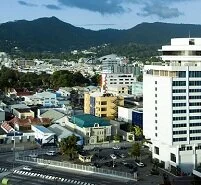Architecture of Trinidad & Tobago

Port-of-Spain
The architecture of Trinidad & Tobago is severely limited as no true buildings exist from the pre-Columbian times. Even the first settlers left little behind as most early architecture was made from wood or other local resources that have been lost to time. Today nearly every architectural piece of note is in the capital of Port of Spain.
Of the earliest still standing monuments in the country is Fort Picton (1798), which was a British fort in the Laventille District of the capital. Moving into the 1800s there are a few buildings still standing, including the Masonic Lodge (1804) and Hayes Court. In the late 1800s the blue limestone President's House was built and remains a city landmark in Port of Spain to this day.
The true building boom began in the 1900s in Port of Spain and one of the finest buildings of this time was the Queen's Royal College, which combines German and Caribbean influences. Other buildings of note built during this time include the French-inspired Mille Fleurs building, the French Ambard's House (or Roomor), the Romanesque-styled Roman Catholic Archbishop's House, and the White Hall in the Moorish style among others.